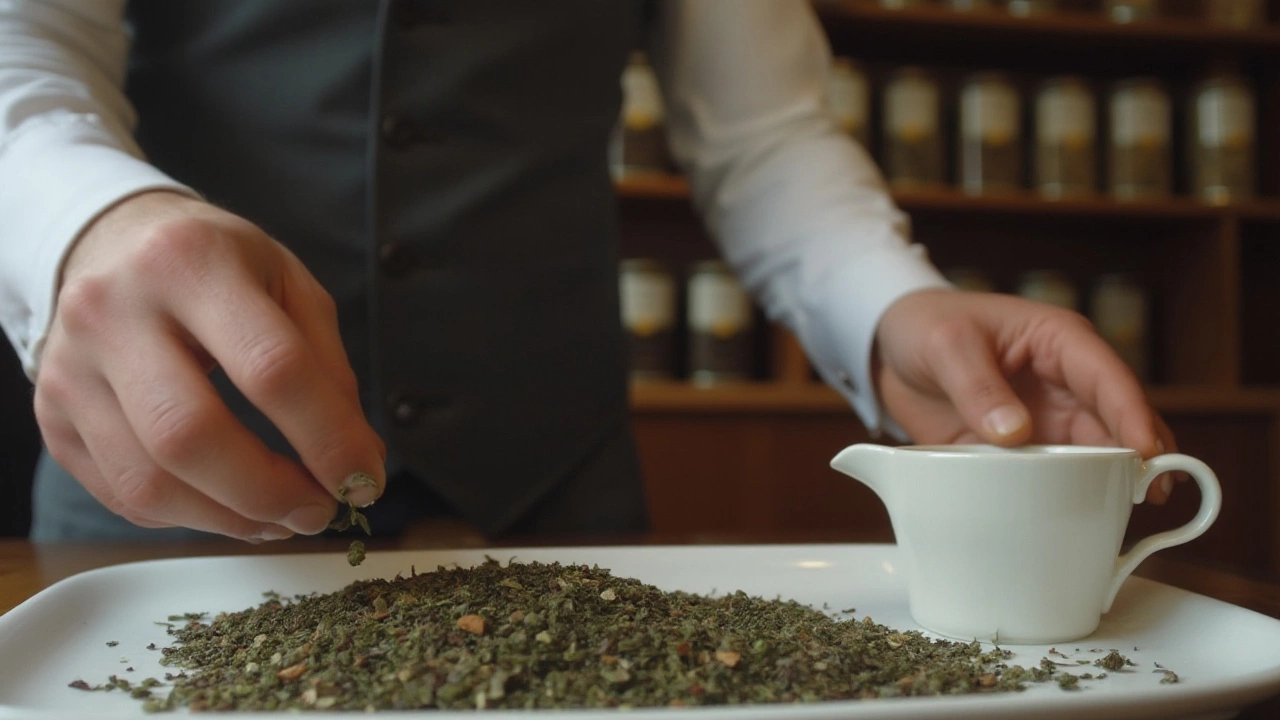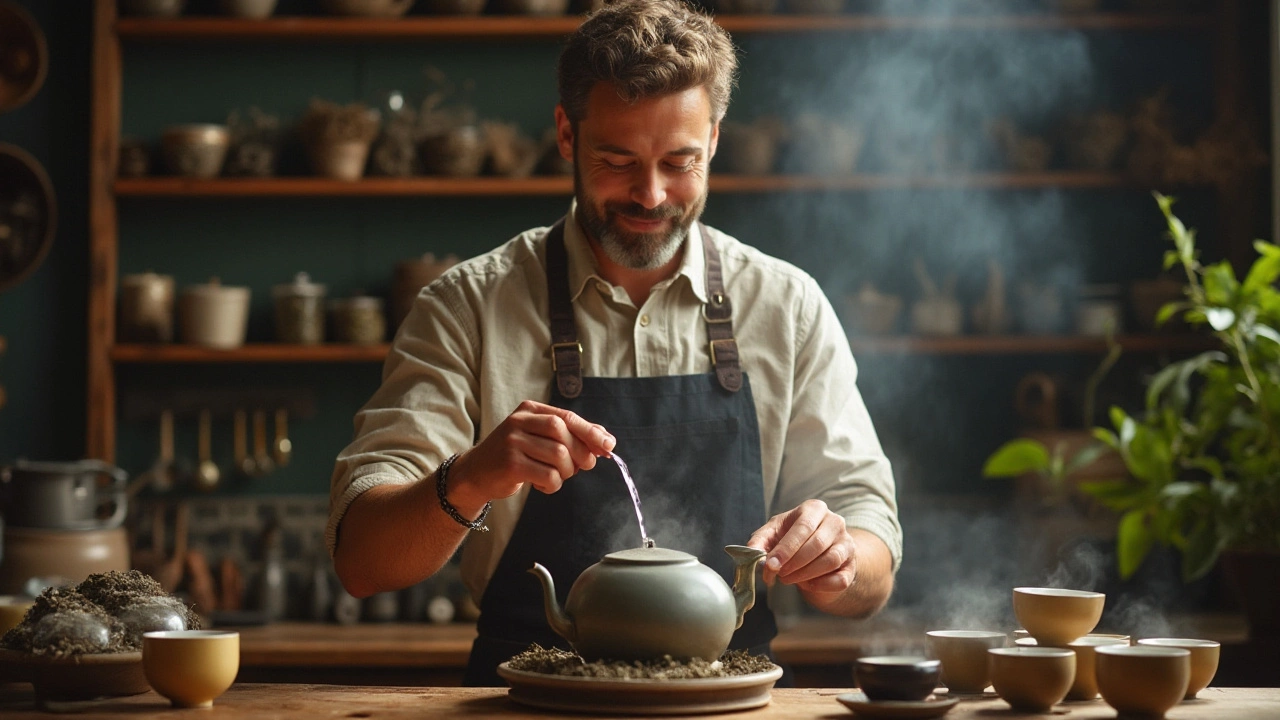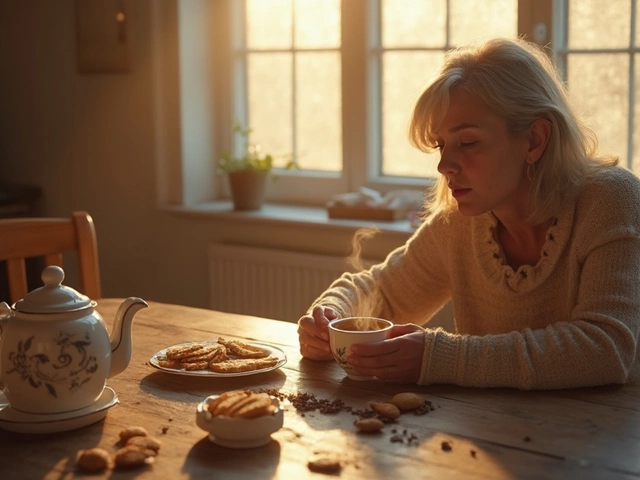Tea tasting is an ancient art that has fascinated beverage connoisseurs for centuries. While it may seem like a simple activity, the process of tea tasting is intricate and detailed, demanding skill and devotion. Whether you're evaluating a delicate green tea or a robust black variety, each cup offers a unique journey of flavors and aromas.
In this guide, we'll unfold the nuances of tea tasting, offering insights into how professionals discern the slightest subtleties in tea. Delve into the world of tea leaves, aromas, and flavors, and discover tips to refine your technique. Prepare to embark on a sensory adventure that heightens your appreciation of tea and unveils new dimensions of this beloved beverage.
- Understanding the Basics of Tea Tasting
- The Importance of Tea Leaf Appearance
- Unveiling Aromas: Smelling Techniques
- The Art of Sipping: Flavor and Mouthfeel
- Recognizing Quality: Evaluating Aftertaste
- Tips for Improving Your Tea Tasting Skills
Understanding the Basics of Tea Tasting
Tea tasting, much like wine tasting, involves engaging the senses to evaluate the beverage's qualities. This centuries-old practice draws from traditions rooted in various cultures, each offering its own perspectives on tea. Historically, the appreciation of tea flavors has been a ritualistic process in places like China and Japan, where the preparation and serving of tea are considered an art form themselves. To embark on this journey, one must first embrace the complexity of flavors present in tea, which can range from floral and fruity to earthy and smoky.
The first step many experts take is to examine the dry leaves. This visual inspection can reveal much about the quality and type of the tea. Leaves should be inspected for color consistency and size, as different types of teas, whether green, black, or oolong, have characteristic appearances. Color can hint at the level of oxidation and processing method, affecting flavor profiles significantly. As one develops a better eye for leaf characteristics, it becomes easier to predict the taste journey the tea will take you on.
Once visually assessed, the leaves are typically infused in hot water. The brewing process itself is a crucial component of tea tasting. The water temperature, steeping time, and type of teapot all play pivotal roles in how the flavors and aromas unfold. For instance, green teas, which are more delicate, often require lower temperatures compared to bolder black teas. Enthusiasts often have varied opinions about how long to steep different teas; however, understanding these nuances is part of what makes honing this skill so enjoyable and rewarding.
Experts suggest smelling the leaves both before and after they’re submerged in water as a way to capture the full spectrum of aromas. Aromas are just as diverse as flavors and can range from floral to spicy. The olfactory senses are keenly tied to taste, and a good tea taster learns to recognize and appreciate these scents to predict the flavor experience to come. This aspect of tea tasting is about more than just the immediate smell; it’s about drawing connections to memories and emotions, adding another layer of appreciation.
Another fascinating facet of tea tasting is how temperature can affect taste. Cooler temperatures often highlight different flavors compared to when the tea is freshly brewed and hot. This aspect requires tasters to be patient and allow their brew to cool slightly before diving in for a taste. Tea tasting combines science and art, involving careful sensorial evaluation and an openness to experience the unexpected. Always remember the words of Sir Thomas Lipton, who said, "Tea time is a chance to slow down, pull back, and appreciate our surroundings." This practice invites enthusiasts to not only taste but also savor, turning a simple act into an enriching ritual.
The Importance of Tea Leaf Appearance
The appearance of tea leaves tells us quite a bit about the quality and type of tea we're dealing with. Before even taking a sip, examining the leaves gives us clues about their journey from plant to cup. For tea tasters, this initial inspection is not just routine; it forms the foundation of quality assessment. When the leaves are unrolled and spread out, their size, shape, color, and uniformity each offer information about the tea's processing and potential flavor profile. Observing these characteristics allows us to predict not only taste but also the freshness and care taken during production. The beauty held in each leaf is a testament to its meticulous crafting.
From the outset, one should look at the color of the leaves. For instance, green teas generally display a vibrant, verdant hue, while black teas often boast deep, rich browns. Oolong teas sit somewhere in between, sometimes with attractive tinges of red or gold. These colors indicate the oxidation level of the tea, an important aspect of its processing. The oxidation stage significantly influences the flavor and should match the expectations for each tea variety. Even tiny discrepancies in color can suggest something unique or amiss. Similarly, the shape of the leaf matters. Orthodox teas, rolled by hand or machine, usually have more defined shapes compared to the broken leaves of CTC (crush-tear-curl) teas, offering a different flavor extraction experience.
Size and uniformity are other crucial factors. Large, even-sized leaves often lead to a balanced brew and are usually indicative of high-quality production methods, as these larger leaves withstand longer steeping times without becoming too astringent. In contrast, small, uneven leaves might suggest lesser quality or even blends of different tea batches. The tea's processing is mirrored in the leaf's condition, and a curated inspection can highlight whether it aligns with expectations. Ripped or torn leaves could suggest rough handling, while intact leaves often symbolize gentle care, preserving complexity within the structure of each leaf.
Texture provides yet another dimension to the appreciation of tea leaves. Glossy leaves might hint at younger shoots, possibly signifying a brisk and slightly more bitter infusion. In contrast, a matte finish could indicate older leaves, often associated with mellow and complex notes. Feeling the leaves gently between fingers can further inform the taster about moisture content and dryness. Freshness can sometimes be judged by the suppleness or brittleness of the leaf, inviting another layer of sensory engagement before the first taste. "The leaf is a canvas that carries the story of the tea," renowned tea master Jane Pettigrew once remarked, capturing the essence of how significant the leaf's appearance is to our tea-tasting journey.
| Characteristic | Interpretation |
|---|---|
| Color | Indicates oxidation level and processing |
| Shape | Highlights orthodox or CTC processing |
| Size | Correlates with quality and steeping potential |
| Texture | Relates to freshness and maturity |

Unveiling Aromas: Smelling Techniques
The art of tea tasting is deeply intertwined with the sense of smell, as the aroma of tea offers vital clues about its flavor profile and origins. Mastering the ability to identify and differentiate these aromas is essential for anyone intent on becoming proficient in this craft. But how does one begin the journey of detecting specific tea flavors through smell? By immersing oneself in conscious and methodical practice, it becomes easier to unlock a tea's aromatic secrets.
Begin by observing the dry leaves, as their aroma can often hint at the tea's flavor potential. Bring the leaves close, inhaling deeply, allowing the essence to fill your nostrils. This initial interaction often reveals subtle notes – earthy, floral, fruity, or even nutty. It's the first step in a journey that will reveal itself even further as the leaves steep. Pay attention, as some teas may surprise you with aromas unfamiliar to your palate. Document these initial impressions, as they will set the foundation for deeper exploration.
Proceed to the next phase by pouring hot water over the leaves, escorting the tea into its aromatic bloom. The water releases more complex notes, unlocking hidden components of the fragrance as it mingles with steam. Place your hands over the rim of the cup, capturing the essence close before inhaling again. This technique essentially traps the steam, allowing a concentrated burst of aroma to emerge. Feel each note; is it vibrant or mellow? Spicy or sweet? Each experience is unique.
Engage with a range of tea enthusiasts to enhance your understanding. Sharing experiences and articulating what you sense can open doors to new descriptors and insights. As David Lee Hoffman, a renowned tea taster, once said,
"The nose is the gateway to a full appreciation of tea's personality."This conversation not only helps in expanding your olfactory library but also builds a community where insights are shared, refined, and cherished.
Refining your ability to assess tea aromas can be an ongoing journey. A recommended exercise is to compare different teas side by side. Use a comparative smelling approach, which can highlight differences and subtleties you might miss in isolation. Explore a range of aromas from delicate white teas to robust pu-erh, and let each steeping serve as an educational encounter. Over time, recognizing these nuanced aromas becomes a natural part of each tasting session.
For a more scientific approach, some tea tasters utilize an aroma wheel—a visual aid dividing possible scents into categories. This tool can serve as a guide, prompting you to consider aromas that might not immediately jump to mind, aiding in the objective assessment of what is encountered as you engage with different teas.
Ultimately, developing proficient smelling techniques can transform tea tasting from a simple sensory endeavor to an enriching exploration. Slow down, be present, and take the time to savor each aroma for the dynamism it represents. In doing so, you allow the tea to tell its story—a tale woven with the care of the growers, the culture from which it hails, and the time-honored traditions of its creation. This connection through aroma is what makes the art of tea tasting so profoundly special.
The Art of Sipping: Flavor and Mouthfeel
Sipping tea is more than just a simple act of drinking a liquid. It's a sensory engagement, a deliberate experience that invites you to delve into the subtle nuances of tea flavors and the textures known as mouthfeel. To truly appreciate a cup of tea, one must understand that each sip tells a story of its own, shaped by its origin, processing, and unique characteristics. As you take a sip, let the liquid linger on your palate; try to isolate and identify the different taste notes. These could range from floral and fruity hints in a fresh green tea to the earthy and smoky undertones in a well-aged pu-erh.
The experience of tea isn't just about the taste; it's also about the sensation it leaves behind, which is what tea tasters refer to as mouthfeel. This term encompasses the texture and weight of the tea as it moves across your palate. Does it feel thin and refreshing like a springtime shower, or is it full-bodied and velvety, reminiscent of a rich broth? Identifying these qualities takes practice and awareness. Professional tasters often use specific language to describe mouthfeel—words like brisk, creamy, or astringent are frequently used. Bai Mu Dan tea, with its delicate yet lingering texture, often exemplifies the balance between flavor and mouthfeel that enthusiasts find novel.
Building Flavor Recognition Skills
Developing your ability to recognize flavors starts with mindful sipping. Consider setting up a tea tasting session with a few different varieties of the same type, say three different oolong teas. This controlled setting allows you to compare side by side and recognize differences you might otherwise overlook. With every sip, try to pinpoint the primary flavors but also the secondary ones that may initially escape your notice. It helps sometimes to taste with a friend or fellow enthusiast because sharing feedback can often reveal notes you might have missed on your own. As the palate develops, tiny nuances become more pronounced, transforming the simple act of sipping into a more profound appreciation of tea's complexity.
In the world of tea, vocabulary plays a key role in how experiences are shared and understood. Perhaps you have heard the Japanese term 'umami,' often associated with savory flavors. It is a feeling often desired in green teas such as the premium Gyokuro, celebrated not just for its vegetal sweetness but also for that savory depth that engages the taste buds differently compared to common sweetness or bitterness. As you practice tasting, try also to explore different terms, much as you would when learning a new language; this allows you to name and thus notice sensations more clearly.
"Tea is a work of art and needs a master hand to bring out its noblest qualities," wrote Okakura Kakuzo in his insightful book, 'The Book of Tea.' His words resonate even today among tea enthusiasts.
Sip after sip, the art of tea tasting invites drinkers to slow down and savor. To embark on this flavorful exploration, patience becomes your closest companion, guiding you through a journey that deepens your connection to the world of tea and helps you become a more discerning enthusiast. Embrace the rich tapestry of sensations awaiting in each cup, and let each moment offer new discoveries.

Recognizing Quality: Evaluating Aftertaste
The aftertaste left by a cup of tea is a fascinating aspect of tea tasting, often revealing secrets of its origin and the care taken in its production. This lingering sensation on the palate is not merely a remnant of the flavor; it serves as a crucial determinant of the tea's quality. When assessing the aftertaste, it's important to note whether it is pleasant, harsh, or even transformative. The persistence and complexity of the aftertaste can offer glimpses into the tea's journey from leaf to cup. One might find a subtle sweetness emerging after a sip of oolong, or a brisk note that distinctly characterizes an Assam black tea.
Evaluating aftertaste involves more than just subjective enjoyment; it's a practice that ties together the sensory trail laid out by the tea. You've already experienced the initial bouquet of aromas and the burst of flavors engulfing your senses. Now, the aftertaste asks you to pay attention to its depth and balance. A quality tea often has an aftertaste that lingers with harmonious notes, leaving the drinker with a sense of satisfaction and a desire for another sip. This lingering expression can be enhanced by the tannins present in the tea, which provide structure and maturity to the overall taste profile. Tannins, found in many types of tea, contribute astringency and dryness, compelling the taster to savor the enduring charm of the aftertaste.
Celia Johnson, a seasoned tea master, once said, "The soul of the tea is whispered in its aftertaste."This perspective highlights how the aftertaste can encapsulate the essence of the tea, offering a final, lingering note that resonates with the drinker's overall experience. Sharp, bitter aftertastes may indicate lower quality leaves or poor processing, while a smooth, sustained finish can speak to the finesse and attention to detail applied during production. Discerning tea enthusiasts will often find complexity in this stage; an aftertaste may evolve, revealing layers and subtleties that were not apparent at first.
To hone the skill of evaluating aftertaste, practice is indispensable. You might consider sampling teas from varied regions, each bringing its profile to the table, literally. Compare how long different teas leave an aftertaste and explore the symphony of flavors that play on your palate. This exploration can deepen your understanding and appreciation of the art of tea making. As you expand your experience, take notes on what your palate discerns, fostering a personal catalogue of aftertastes that resonate with you. By enhancing your awareness of a tea's aftertaste, you engage more intimately with the tea, recognizing the quality that reflects its creator's vision.
Tips for Improving Your Tea Tasting Skills
Becoming adept at tea tasting requires practice and passion, but certain tips can significantly boost your expertise. To start, it's important to create and consistently use a dedicated tasting environment. This space should be free from distracting odors or smells, allowing the pure essence of the tea to be experienced without interference. Many tea tasters emphasize the importance of using the right tools: a clear teapot or gaiwan can help observe changes in tea leaves during steeping, offering visual clues about its type and quality. Additionally, a timer is essential to maintain brewing consistency, as over-steeping or under-steeping can alter the intended flavor profile of the tea.
Tasting the same tea flavors repeatedly under different conditions is crucial. This means trying the tea at various temperatures, using different water types, and infusing it for varied durations. This practice helps in understanding how every element affects the taste, aroma, and mouthfeel. Documenting these observations, not just in terms of taste but also in terms of aromas and textures, can help in fine-tuning one's skills. A tea journal can be a beneficial tool, providing insights into patterns and preferences over time. This structured reflection process aids in developing a more sophisticated palate.
"Tea is the whispering voice of an ancient culture, a brew connecting us to the earth's past and its future," remarks renowned tea expert Lin Yutang.Embracing a community approach to learning can also be helpful. Engaging with tea enthusiasts online or in local clubs can offer fresh perspectives and new methods. Each person's experience can add richness to your understanding. Exchange notes, participate in group tastings, or discuss trends with fellow aficionados to broaden your horizons. Collaborative learning often leads to eureka moments that can transform a mundane tasting experience into an insightful journey.
Below is a simple guideline that helps in ensuring your tea tasting sessions become progressively better:
- Maintain Consistency: Practice the same routine while tasting to develop a reliable system.
- Experiment: Do not hesitate to try unconventional methods or pairings, as surprises often enrich the learning process.
- Education: Immerse yourself in tea literature, watch instructional videos, or attend workshops to deepen your knowledge.
- Calm the Mind: Quiet your surroundings and focus on the immediate sensory experience of tasting.
- Network: Connect with seasoned tasters who can provide valuable feedback and encouragement.
Finally, patience remains paramount. Tea tasting isn't about rushing to identify flavors, but about savoring each sip's story. It's a personal odyssey; your skill will mature like a fine tea with time. Enjoy the process, embrace each cup fully, and, most importantly, let the experience enrich your daily life.


